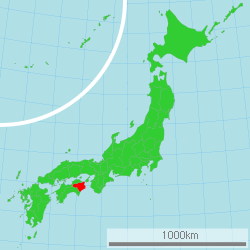Tokushima Prefecture
This article may have too many red links. (April 2020) |
Tokushima
徳島県 | |
|---|---|
| Japanese transcription(s) | |
| • Romaji | Tokushima-ken |
 Location of Tokushima in Japan | |
| Coordinates: 34°2′N 134°26′E / 34.033°N 134.433°E | |
| Country | |
| Region | Shikoku |
| Island | Shikoku |
| Capital | Tokushima (city) |
| Government | |
| • Governor | Masazumi Gotōda |
| Area | |
| • Total | 4,144.95 km2 (1,600.37 sq mi) |
| • Rank | 36th |
| Population (October 1, 2001) | |
| • Total | 824,108 |
| • Rank | 44th |
| • Density | 200/km2 (510/sq mi) |
| ISO 3166 code | JP-36 |
| Prefectural flower | Sudachi (Citrus sudachi) |
| Prefectural tree | Yamamomo (Myrica rubra) |
| Prefectural bird | White heron |
| Number of districts | 8 |
| Number of municipalities | 24 |
| Website | pref.tokushima.jp/english/ |
Tokushima Prefecture (徳島県, Tokushima-ken) is a prefecture in the Shikoku region of Japan on the island of Shikoku.[1] The capital city is the city of Tokushima.[2]
History
[change | change source]Until the Meiji Restoration, Tokushima prefecture was known as Awa Province.[3]
Timeline
[change | change source]- 4th century BC – Rice farming of the Yayoi period in Awa[4]
- 3rd century AD – Burial mounds of the Kofun period in Awa[4]
- 8th century – Wooden tablets (mokkan) used for record-keeping in Awa[4]
- 1586 (Tenshō 14): Tokushima castle.[5]
- 1625 (Kan'ei 2): Indigo monopoly established[4]
- 1945 (Shōwa 20): Tokushima City bombed by Allied planes[4]
Geography
[change | change source]Tokushima is in the northeastern part of Shikoku. The prefecture faces the Seto Inland Sea and the Pacific Ocean. Kagawa Prefecture is to the northeast. Ehime Prefecture is to the west. Kōchi Prefecture is to the southeast.
Tokushima and Kagawa have disagreed about sharing water for a since the 1850s. The Yanase Dam was built in 1953.[6]
Cities
[change | change source]
|
Towns and villages
[change | change source]Towns and villages in each district:
National Parks
[change | change source]National Parks are established in about 9% of the total land area of the prefecture.[7]
Shrines and Temples
[change | change source]Ōasahiko jinja is the chief Shinto shrine (ichinomiya) in the prefecture. [8]
Related pages
[change | change source]- Provinces of Japan
- Prefectures of Japan
- List of regions of Japan
- List of islands of Japan
- Tokushima Vortis
References
[change | change source]- ↑ Nussbaum, Louis-Frédéric. (2005). "Tokushima prefecture" in Japan Encyclopedia, p. 980; Japan External Trade Organization(JETRO), Tokushima Prefecture, Regional Information Archived 2013-01-27 at the Wayback Machine; retrieved 2012-4-6.
- ↑ Nussbaum, "Tokushima" at p. 980.
- ↑ Nussbaum, "Awa no Kuni" at p. 62; "Provinces and prefectures" at p. 780.
- ↑ 4.0 4.1 4.2 4.3 4.4 Tokushima Prefectural Museum, Permanent exhibitions Archived 2012-03-09 at the Wayback Machine; retrieved 2011-11-22.
- ↑ Japan Cultural Profile, Tokushima Castle Museum; retrieved 201122-22.
- ↑ Berga, L. (2006). Dams and Reservoirs, Societies and Environment in the 21st Century, Vol. 1, p. 41.
- ↑ Japan Ministry of the Environment, "General overview of area figures for Natural Parks by prefecture"; retrieved 2012-3-13.
- ↑ "Nationwide List of Ichinomiya," p. 3 Archived 2013-05-17 at the Wayback Machine; retrieved 2012-2-9.
Other websites
[change | change source]![]() Media related to Tokushima prefecture at Wikimedia Commons
Media related to Tokushima prefecture at Wikimedia Commons
- http://www.pref.tokushima.jp/english/ Archived 2009-12-31 at the Wayback Machine; http://www.pref.tokushima.jp/ Archived 2009-12-31 at the Wayback Machine



